Rhynia enigmas old and new
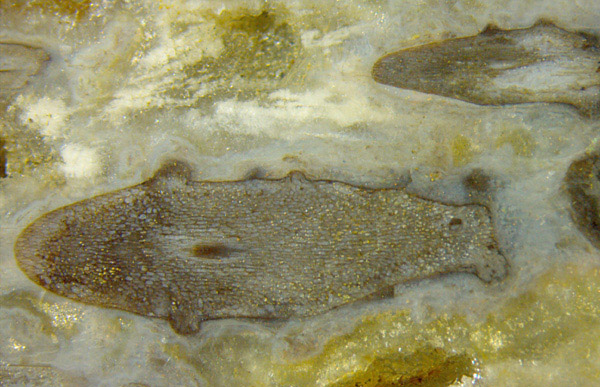
The enigmas concerning Rhynia
are of quite different kinds. The first one is obsolete now that it is
known that those ones of the abundant plant fossils in the Rhynie chert
originally called Rhynia
[1] belong to two species. The bigger and more abundant species has got
the name Aglaophyton
but the smaller and less
abundant one has retained the name Rhynia.
As a peculiar feature of the latter, wart-like
protrusions
are not seldom seen on the cylindrical surface, usually no more
than one on a section but most often none at all. Hence, the
occurrence of several warts on one section as in Figs.1,2 is
exceptional. Their purpose is uncertain
but a proposed interpretation in [2], supported by a convincing image,
seems to come close to the truth: "They could have been small organs
from which root hairs grew when the
plant was touching the ground". The
warts seen on the numerous own Rhynia
sections, however, have not yet revealed another
case of unicellular root hairs grown from them.
Usually the warts seem to be sparsely
and randomly
distributed on the cylindrical surface of the Rhynia stems. Seldom but
apparently more often than expected, two of them are seen in opposite
positions on the stem, as in Figs.1,2. It is not known whether this is
merely incidental.
Fig.1: Inclined sections of Rhynia with
wart-like protrusions. Image width 10mm.
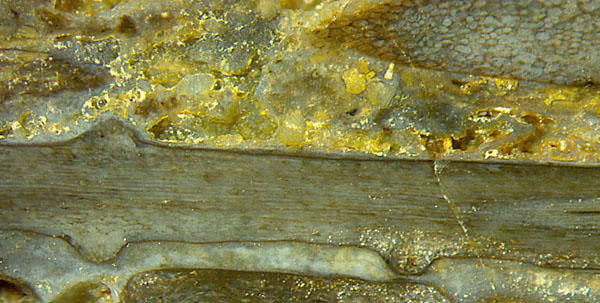
Fig.2: Lengthwise section
of Rhynia
with wart-like protrusions. Image width 5mm.
Note
that the scale of Fig.2 is twice that of Fig1. The stem diameter in
Fig.1 is rather big, about 2.4mm, but the one in Fig.2 is rather small,
about 0.8mm. Usually the diameter is 1-2mm. Such variability is well
known with Rhynia.
The
slanting
cut in Fig.2 above right shows the tissue structure of the outer
regions of a bigger stem.
A small wonder in connection with this
sample may be briefly mentioned here: It is the conspicuously different
mineralisation of two Rhynia
stem parts having lain side by side in the
siliceous water in the Devonian but looking quite different in the
chert now: Fig.3. This phenomenon does not seem to be restricted to
Rhynia but
is particularly well seen here, along with but unrelated to
the enigmas of this chert sample as illustrated in Figs.2,4.
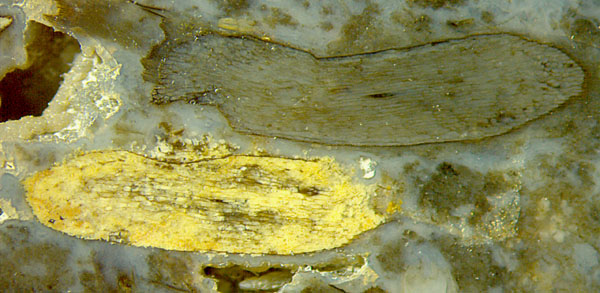
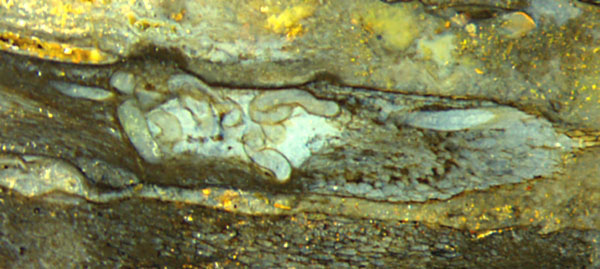
Fig.3 (left): Differently mineralized Rhynia.
Image width 5mm.
Fig.4: Section of
Rhynia with
wart-like protrusions and big
hole with unique
worm-like objects. Image width 5mm.
Fig.5 (below right): Worm-like objects in Fig.4.
Image width 2mm.
The structure seen in Figs.4,5 is possibly the
most enigmatic one. From
the observation that big cavities
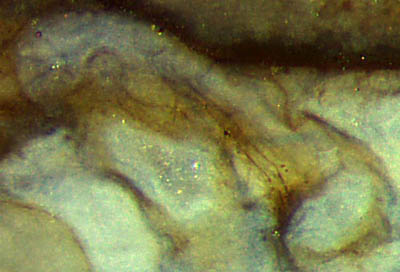 inside Rhynia
are
apparantly never related to warts on the surface, it
may be concluded that the combination seen here is incidental
and hence irrelevant. The unique
combination of the big cavity with worm-like limp objects of
0.12-0.18mm width suggests
a causal connection in the way of "worms eat Rhynia tissue and
leave a big hole". This seemingly simple idea, however,
is questioned by the fact that
the tubes do not readily reveal creature-like details. They are not
torn like moults when strongly bent. They seem
to be structureless inside, perhaps with the exception
of a poorly preserved one
(Fig.6), which contains a lengthy structure looking like a rugged
tube of about 20Ám diameter, possibly the
gut or axis of some creature.
inside Rhynia
are
apparantly never related to warts on the surface, it
may be concluded that the combination seen here is incidental
and hence irrelevant. The unique
combination of the big cavity with worm-like limp objects of
0.12-0.18mm width suggests
a causal connection in the way of "worms eat Rhynia tissue and
leave a big hole". This seemingly simple idea, however,
is questioned by the fact that
the tubes do not readily reveal creature-like details. They are not
torn like moults when strongly bent. They seem
to be structureless inside, perhaps with the exception
of a poorly preserved one
(Fig.6), which contains a lengthy structure looking like a rugged
tube of about 20Ám diameter, possibly the
gut or axis of some creature.
Fig.6, detail of Fig.5: Worm-like object, apparently
revealing some indistinct structure
inside. Image width 0.67mm.
So it appears that one small piece of Rhynie
chert may reveal peculiar
phenomena of quite different nature which contributes to the
fascination with the chert but possibly also to
confusion. Comparison with other samples, of course, can be helpful
but more often than not some problems remain unresolved as long as no
comparable fossil matter is available.
Samples: Fig.1: Rh12/150 (0.64kg)
found in 2007, Part 2; Figs.2-6: Rh16/6 (0.37kg)
found in 2008, Part 3.
H.-J.
Weiss 2020
[1] R.
Kidston, W.H. Lang : On Old Red Sandstone plants showing
structure from the Rhynie Chert bed, Part I,
Trans. Roy. Soc. Edinburgh 51(1917),
761-84.
[2] H. Steur:
Hans' Paleobotany Pages.
steurh.home.xs4all.nl, Rhynia
gwynne-vaughanii .
 |
 |
159 |







 inside Rhynia
are
apparantly never related to warts on the surface, it
may be concluded that the combination seen here is incidental
and hence irrelevant. The unique
combination of the big cavity with worm-like limp objects of
0.12-0.18mm width suggests
a causal connection in the way of "worms eat Rhynia tissue and
leave a big hole". This seemingly simple idea, however,
is questioned by the fact that
the tubes do not readily reveal creature-like details. They are not
torn like moults when strongly bent. They seem
to be structureless inside, perhaps with the exception
of a poorly preserved one
(Fig.6), which contains a lengthy structure looking like a rugged
tube of about 20Ám diameter, possibly the
gut or axis of some creature.
inside Rhynia
are
apparantly never related to warts on the surface, it
may be concluded that the combination seen here is incidental
and hence irrelevant. The unique
combination of the big cavity with worm-like limp objects of
0.12-0.18mm width suggests
a causal connection in the way of "worms eat Rhynia tissue and
leave a big hole". This seemingly simple idea, however,
is questioned by the fact that
the tubes do not readily reveal creature-like details. They are not
torn like moults when strongly bent. They seem
to be structureless inside, perhaps with the exception
of a poorly preserved one
(Fig.6), which contains a lengthy structure looking like a rugged
tube of about 20Ám diameter, possibly the
gut or axis of some creature. 
